There are over 40 species that belong to the family Casuarinaceae, that include the Allocasuarina decaisneana, known as the Desert Oak. The desert oak is a slow-growing medium-sized tree found in the arid desert regions of Central Australia, encompassing parts of the Northern Territory, South Australia and Western Australia.
Originally named Casuarina decaisneana in 1858 by botanist Ferdinand von Mueller, it was reclassified in 1982 into the genus Allocasuarina by Lawrence Alexander Sidney Johnson. The name decaisneana was in honour of the Belgian botanist Joseph Decaisne, who had never been to Australia, nor had he ever seen the tree.
The name casuarina is derived from the Latin casuarius, that is the name for the cassowary (the branches / modified leaves resembling cassowary feathers). The prefix of allo comes from the Greek allos meaning other or different from.
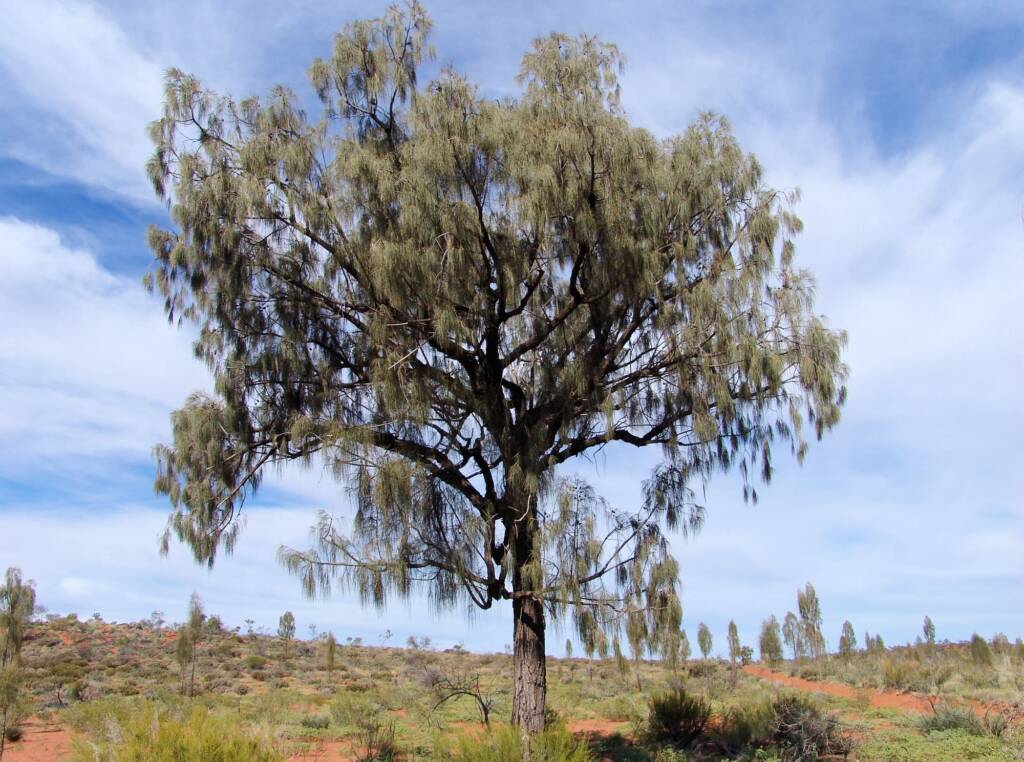
Casuarinas are bushes / trees with striated jointed branches. The leaves themselves are reduced to scales and occur at joints in the droopping branchlets.
The young juvenile desert oak trees have a prickly foliage, deterring grazing animals from eating it. The juvenile shape is very different to that of the adult tree, being thin and straight in shape and described by some as looking like feather dusters. The juvenile trees send down a strong tap root looking for the water table and a more reliable water supply. When they reach water they grow taller and become adult trees, sending out side branches, transforming into a tree with weeping shape and smooth foliage.
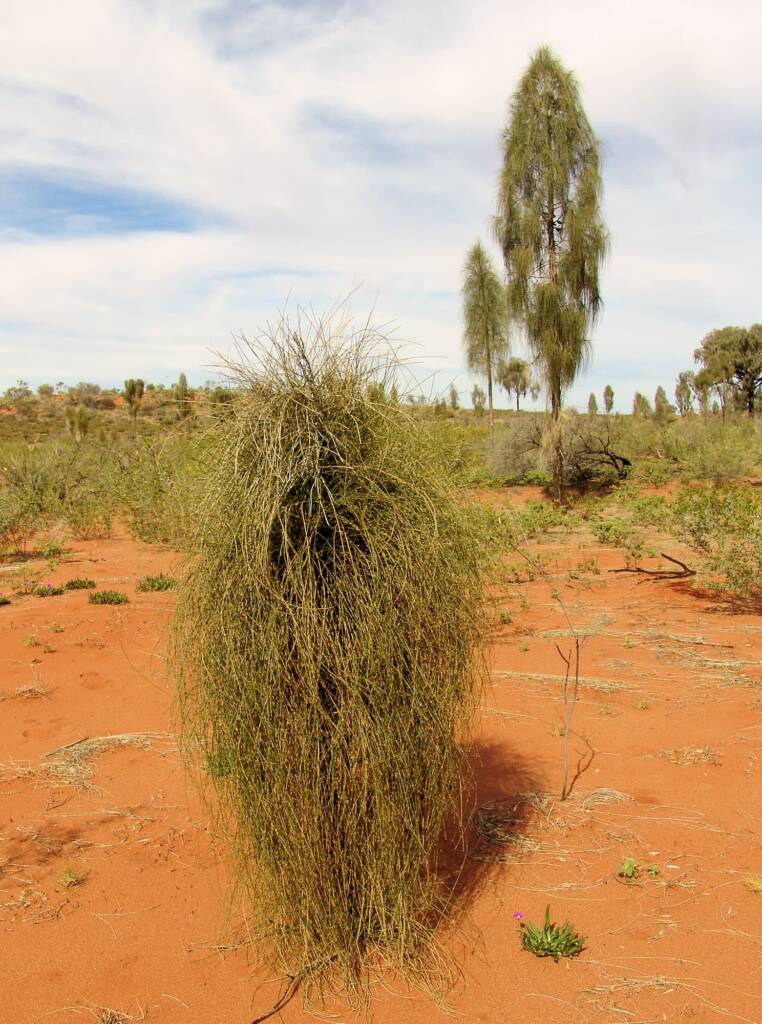
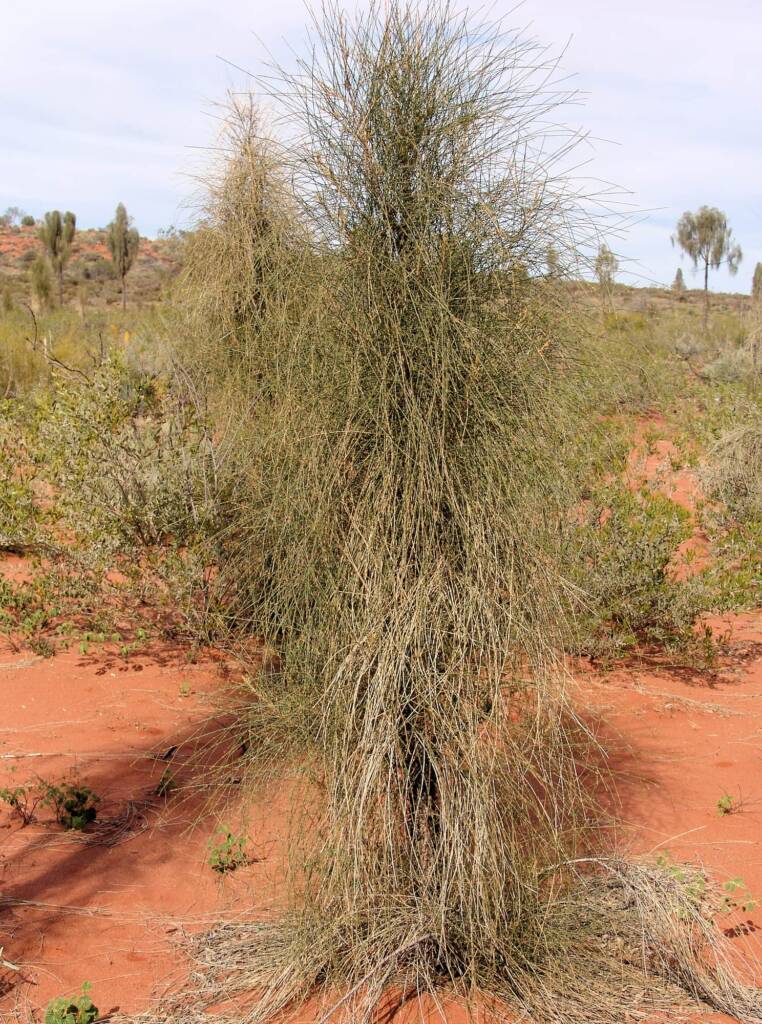
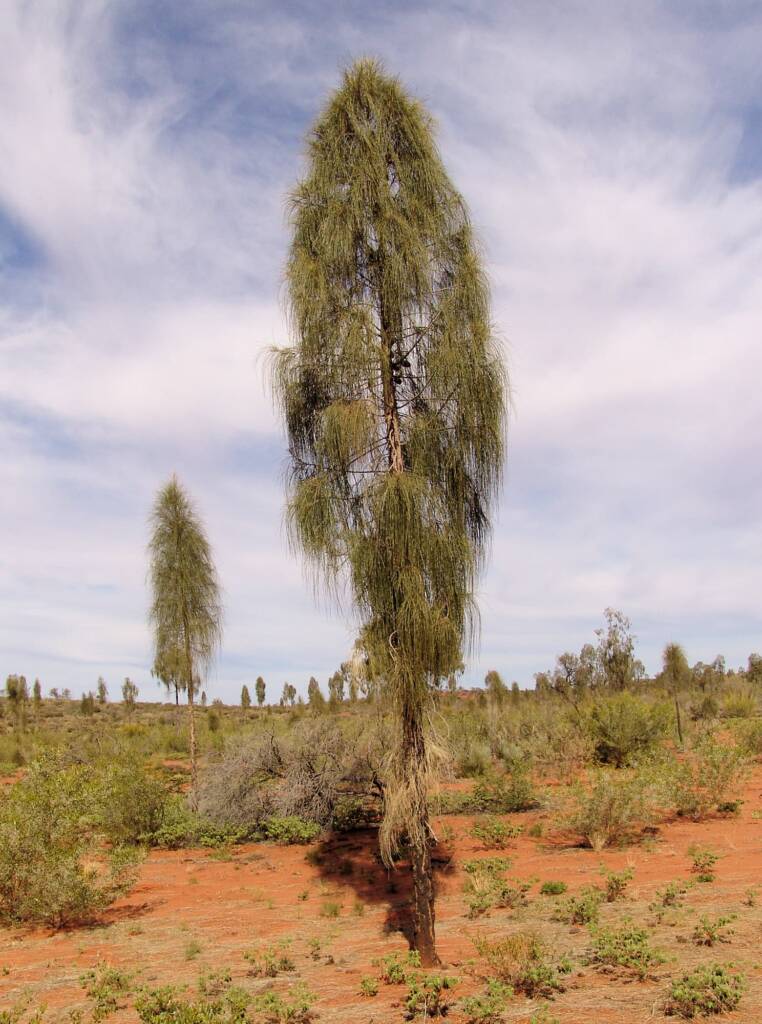
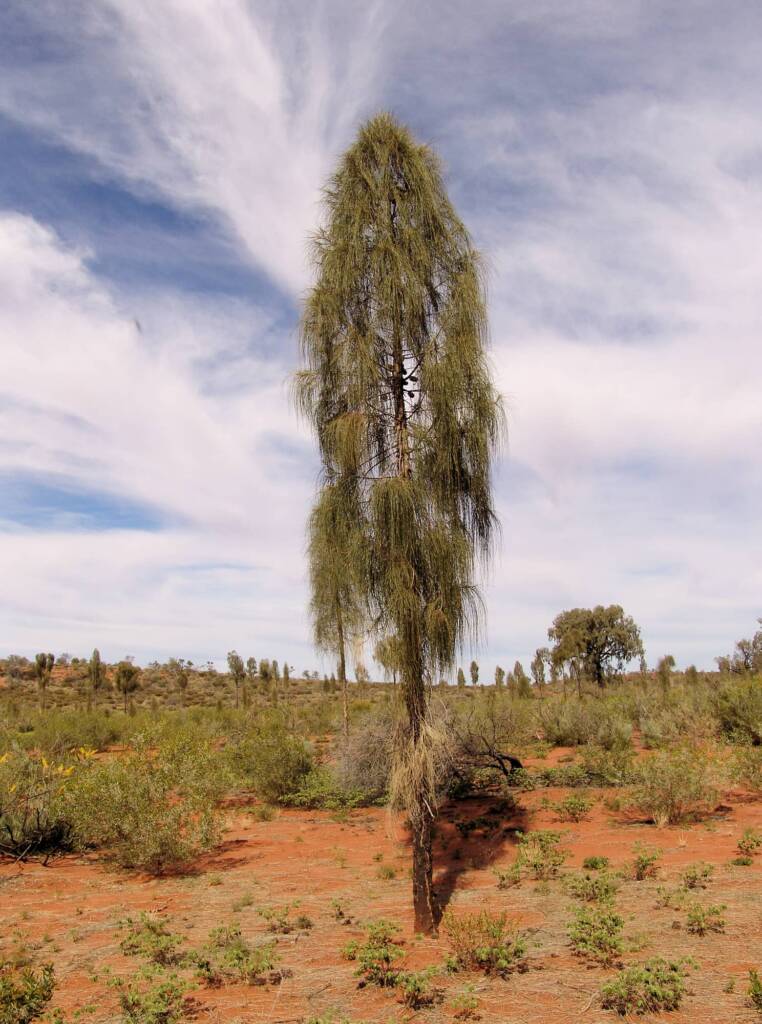
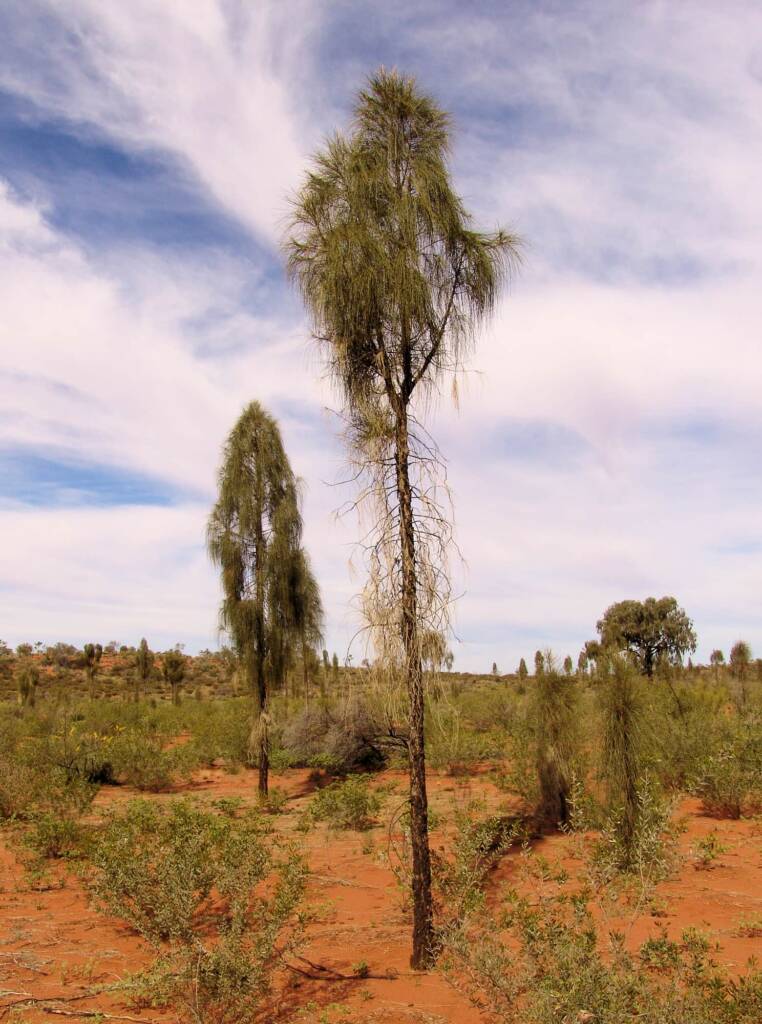
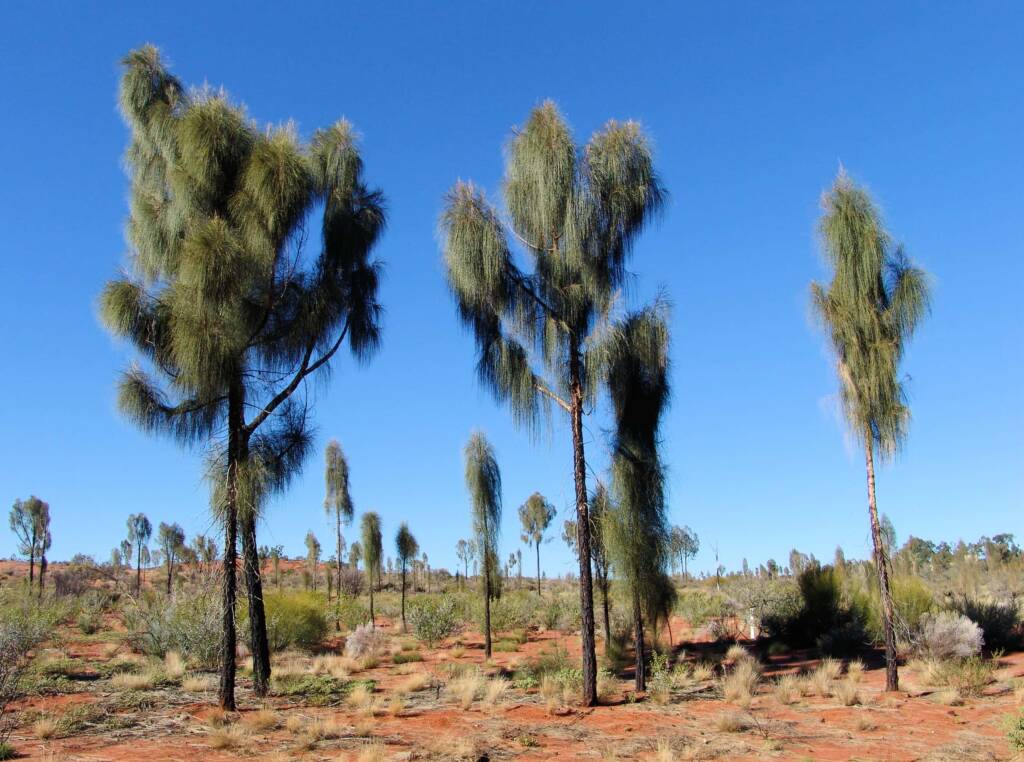
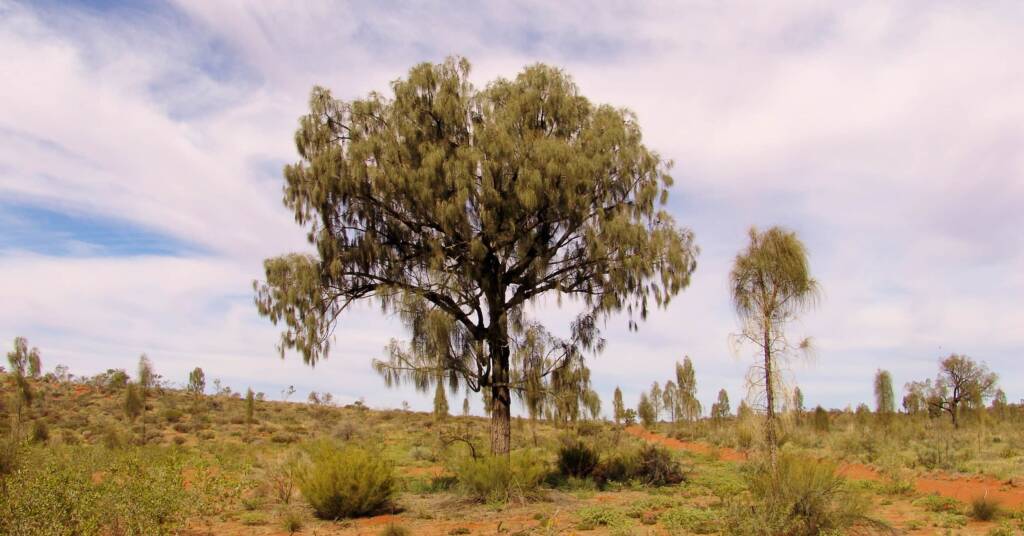
The trees themselves have a number of other adaptations for survival, especially after fire. These include a thick bark and the ability to produce epicormic shoots (this type of growth regenerates from an epicormic bud that lies underneath the bark of the tree), and the production of a huge amount of seeds, that like other Australian plants are assisted by bush fires in germination.
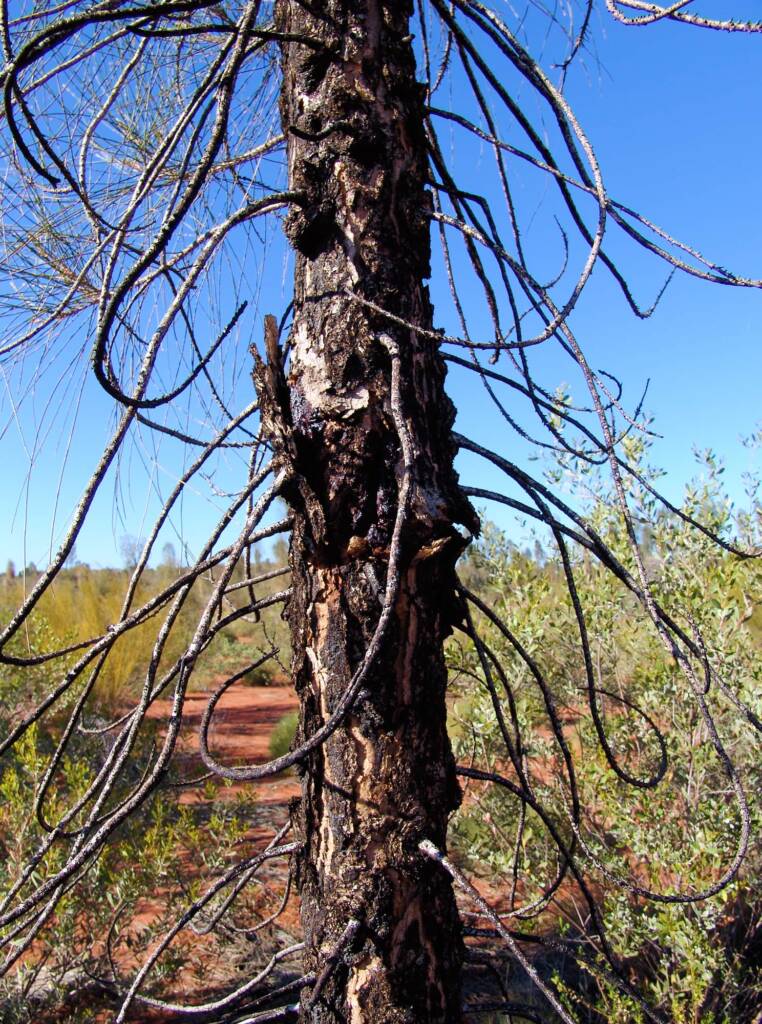
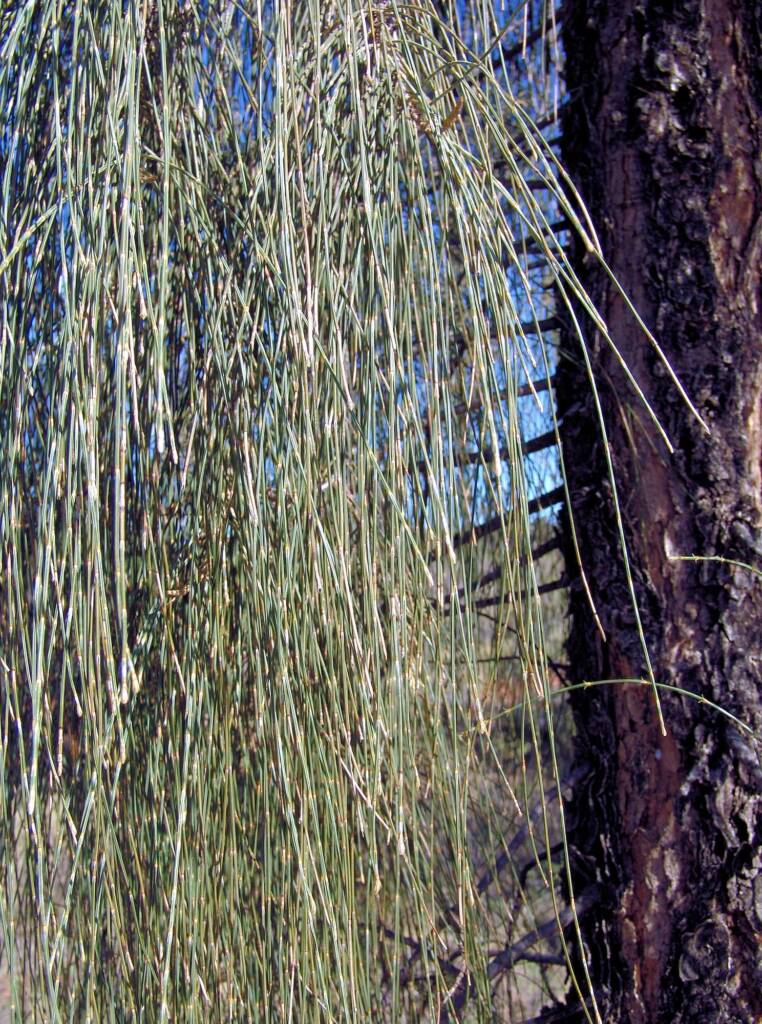
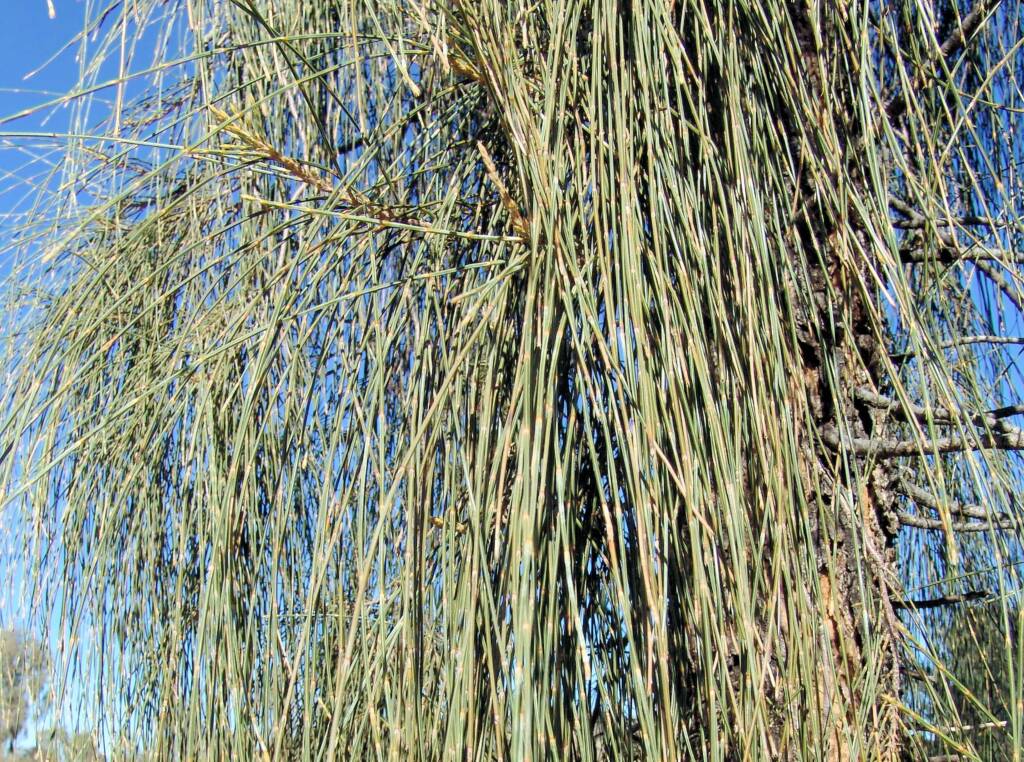
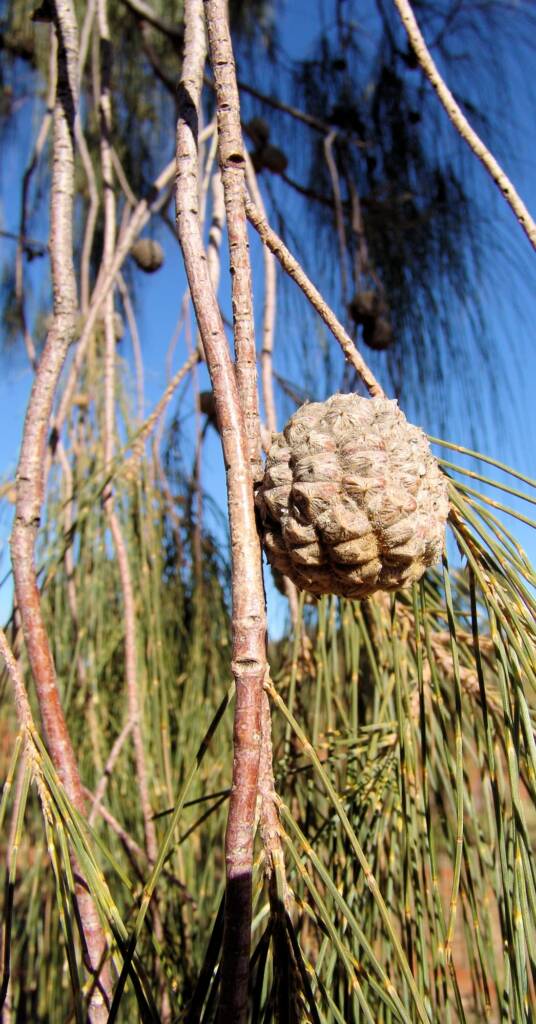
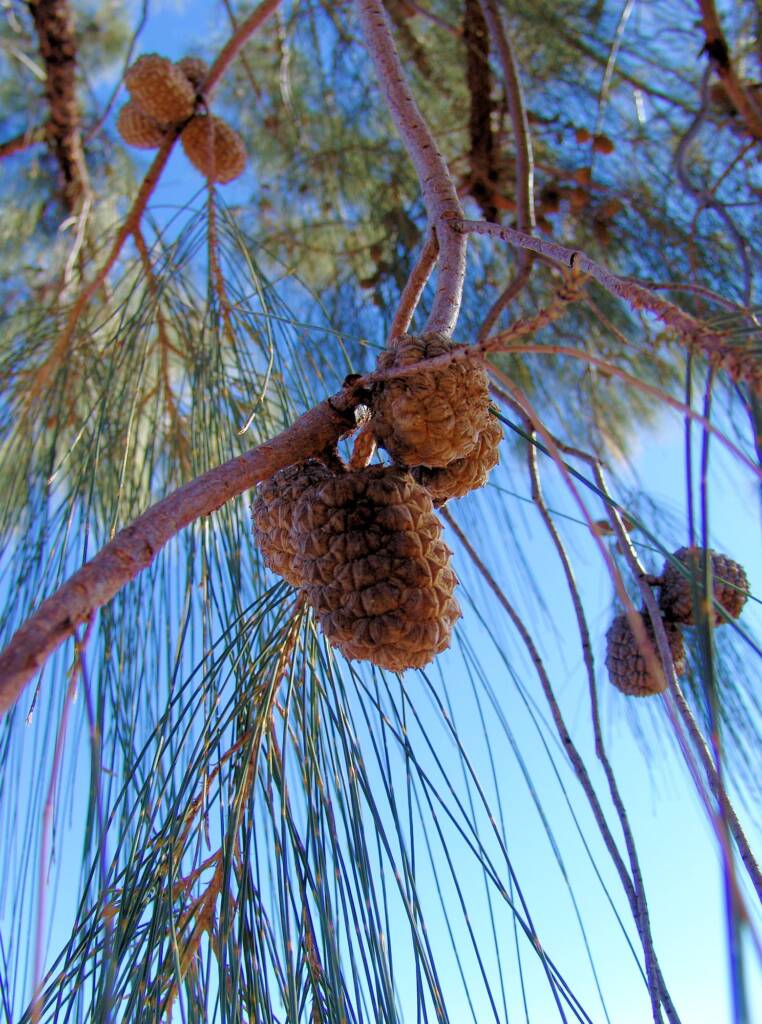
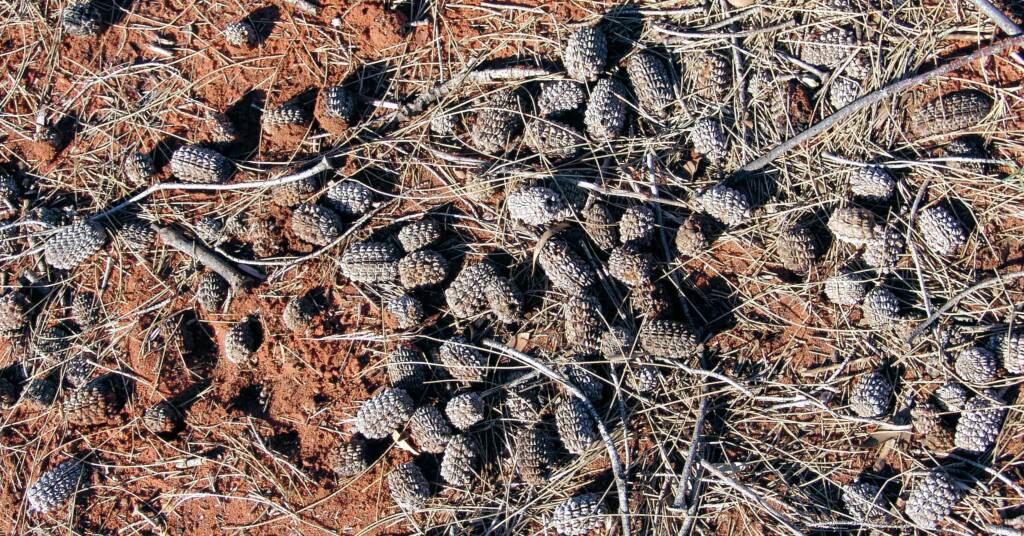
The trees are often found in large stands in sandy spinifex areas. Visitors to Central Australia can see the trees in and around Uluru-Kata Tjuta National Park, Rainbow Valley and at the Alice Springs Desert Park.
This majestic desert oak tree is one of Central Australia’s iconic trees and is a significant tree in Aboriginal culture and Aboriginal dreaming.
Aboriginal people have eaten the seeds and soaked the cones in water to drink the liquid. Water was also said to be retrieved from the desert oak tree hollows. The wood of the tree was used to make clubs and spears, with the deadwood favoured for firewood and to produce ash for making pituri.1, 2
Common name
Eastern Arrernte know it as irrkepe
Western Arrernte know it as arrkepe
Pintupi know it as intarra, urpa, kurrkapi, kurrkara, nyirrpi, ularrangu, witirrpa, yintarra, yularrangu, tatu (reference to the seed pod)
Pitjantjatjara know it as kurkapi, kurkara, kirtjiti
Warlpiri know it as kurrkapi, kurrkara.
The Desert Oaks provides shade in the country of Mina Mina, an important women’s dreaming site where women gather for ceremonies. It is found painted in the artwork of aboriginal artists of the central and western deserts. “Desert Oak Dreaming” is a major subject and is found depicted in the works of artists from art centres such as Warlukurlangu in Yuendumu.
During the Jukurrpa (Dreaming) ancestral women of the Napangardi and Napanangka sub-section groups (aunt / niece relationship, in which knowledge is passed from one to the other) gathered to collect ceremonial digging sticks that had emerged from the ground from the desert oak trees (Allocasuarina decaisneana) which continue to grow today.
Source: Gallery Gondwana
Internationally renowned artist Dorothy Napangardi references the desert oak in many of her works.
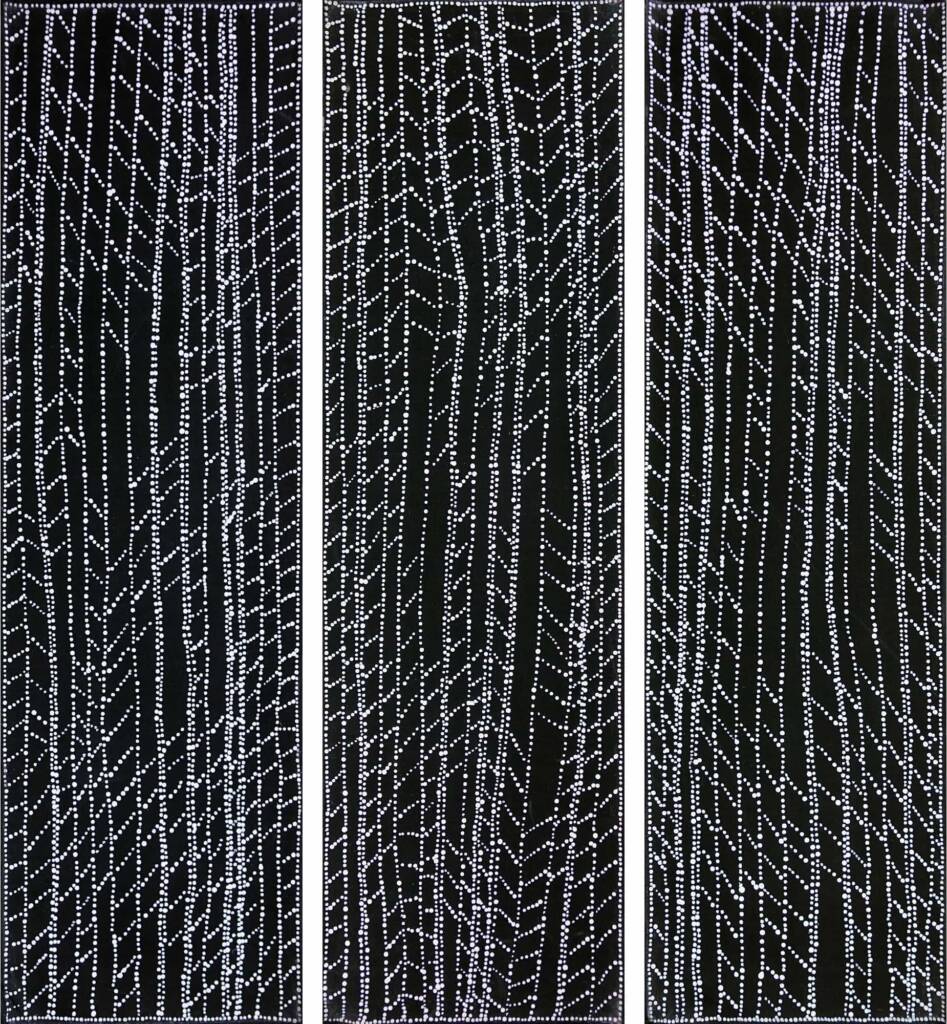
In the triptych we see a forest of desert oak trees. Very slow growing, their root system is a third (at least ) of the tree, reaching far down to access the water. These beautiful trees are quite majestic in this far west part of the central desert of Australia. One can understand the importance they hold in many dreaming stories.
Dorothy Napangardi: Honouring and Remembering the Art and Life of Dorothy Napangardi 1987-2013
Dorothy Napangardi also did a series of limited edition prints, among which included the Kana-kurlangu Jukurrpa (Digging Stick Dreaming):
Digging Sticks are very important for women as they are used as a utilitarian object when hunting and collecting food but also in ceremonies that correspond to abundance and fertility. They are often placed in a hole in the centre of the sand paintings on the ceremonial ground and painted with ochre.
In the Dreaming it is the songs that Napangardi/Napanangka women sang that caused the Desert Oak trees to come out of the ground, creating the first digging sticks at the site of Mina Mina in the western desert.
Source: Gallery Gondwana – Kana-kurlangu Jukurrpa (Digging Stick Dreaming)
- Scientific classification
- Kingdom: Plantae
- Phylum: Charophyta
- Class: Equisetopsida
- Subclass: Magnoliidae
- Superorder: Rosanae
- Order: Fagales
- Family: Casuarinaceae
- Genus: Allocasuarina
- Species: Allocasuarina decaisneana
Footnote & References
- Bushfires & Bushtucker: Aboriginal Plant Use in Central Australia by Peter Latz; IAD Press; p122-123
- “Review of how indigenous people managed for water in desert regions of Australia”, I A E Bayly, 1999; p22
- Dorothy Napangardi: Honouring and Remembering the Art and Life of Dorothy Napangardi 1987-2013, Gallery Gondwana
- Allocasuarina decaisneana (F.Muell.) L.A.S.Johnson, Desert Oak, https://bie.ala.org.au/species/https://id.biodiversity.org.au/node/apni/2902296
FloraFlora in Australia Flora Index Acacia Anigozanthos (Kangaroo Paws) Annual Yellowtop Apium prostratum subsp. prostratum var filiforme Apple Bush (Pterocaulon sphacelatum) Australian Bluebell Australian Gossypium Banksia Batswing Coral Tree Billy Buttons Birdsville Indigo Blue Pincushion Bush Banana Callistemon Callitris drummondii (Drummond’s Cypress Pine) Calothamnus quadrifidus Cape Honeysuckle Cassia fistula (Golden Shower) Cattle Bush Common Heath Crotalaria Darwinia wittwerorum (Wittwer’s Mountain Bell) Daviesia oppositifolia (Rattle-pea) Desert Oaks Drumsticks Eremophila Eucalyptus Ficus Flannel Cudweed (Actinobole uliginosum) Georges Indigo Goatshead Burr (Sclerolaena bicornis) Golden Everlasting Goodenia Gossypium Grass and Grasses Grass Trees Grevillea Grey Germander Hakea Kapok Bush (Aerva javanica) Lambertia sp Leptospermum MacDonnell Ranges Cycad Maireana scleroptera Mexican Poppy Minnie Daisy Mistletoe Family Nardoo Native Apricot Nicotiana megalosiphon subspecies sessilifolia Nuytsia floribunda Orange Spade Flower Orchidaceae Parakeelyas (Calandrinia) Pebble Bush (Stylobasium spathulatum) Perennial Yellow Top Pink Everlasting Pink Rock Wort Poached Egg Daisy Portulaca Proteaceae Ptilotus Quandong Resurrection Fern Rosy Dock Ruby Saltbush Santalum Solanum Spike Centaury Spinifex Storkbill (Erodum cygnorum) Striped Mint Bush Sturt’s Desert Pea Sturt’s Desert Rose Tall Saltbush Tangled Leschenaultia Tar Vine Tribulus eichlerianus Upside-down Plant Urodon dasyphylla Variable Daisy Waratah (Telopea) Wertabona Daisy White Cedar (Melia azedarach) White Indigo White Paper Daisy Wild Passionfruit Wild Stock Woolly-Headed Burr Daisy Woolly Bush Yellow-keeled Swainsona
Flora & FaunaFauna Flora Fauna Flora Funga Glossary Funga Related Topics Scientific Classification Backyard Wildlife Floral Emblems of Australia Wildflowers
